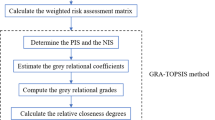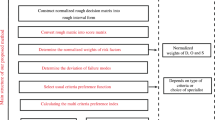Abstract
Failure mode and effect analysis (FMEA) is a forceful way for preventing the occurrence of possible damages before the process of management activities, which is widely utilized in various fields. However, experts’ bounded rationality, imprecise risk assessments and unobjective risk factors’ weights are prominent challenges existed in the conventional FMEA model. Thus, to better meet the challenges and further improve the performance of FMEA, this paper constructs a novel FMEA model for risk ranking by integrating the TODIM with the PROMETHEE II technique under q-rung orthopair fuzzy environment. Considering the fuzziness and uncertainty in risk assessments, q-rung orthopair fuzzy sets (q-ROFSs) are utilized to assist experts in describing their actual opinions concerning each failure modes flexibly and freely. Further, based on the proposed normalized projection model for q-ROFSs, a comprehensive criteria weighting determination method is employed for obtaining the optimal weights and a novel distance measurement of q-ROFSs is also further presented. Subsequently, the integrated TODIM-PROMETHEE II technique is developed for ranking failure modes, which has the ability of considering risk aversion behavior of experts. After that, the detailed steps are depicted via a representative case in blood transfusion. Finally, the comparative analysis is conducted to verify the stable and superiority of the FMEA method proposed in this paper. The proposed method under q-ROF environment can solve some cases which the traditional FMEA technique cannot, as well as helping experts to express their opinions flexibly, which improves the implementation accuracy of the FMEA.



Similar content being viewed by others
References
Miljković, N., Godman, B., van Overbeeke, E., Kovačević, M., Tsiakitzis, K., Apatsidou, A., et al.: Risks in antibiotic substitution following medicine shortage: a health-care failure mode and effect analysis of six European Hospitals. Front. Med. 7, 157 (2020)
Liu, H.C., You, X.Y., Tsung, F., Ji, P.: An improved approach for failure mode and effect analysis involving large group of experts: an application to the healthcare field. Qual. Eng. 30(4), 762–775 (2018)
Akyuz, E., Akgun, I., Celik, M.: A fuzzy failure mode and effects approach to analyse concentrated inspection campaigns on board ships. Maritime Policy Manag. 43(7), 887–908 (2016)
Kurt, L., Ozilgen, S.: Failure mode and effect analysis for dairy product manufacturing: practical safety improvement action plan with cases from Turkey. Saf. Sci. 55, 195–206 (2013)
Zadeh, L.A.: Fuzzy sets. Inf. Control 8(3), 338–353 (1965)
Atanassov, K.T.: Intuitionistic fuzzy sets. In: Intuitionistic Fuzzy Sets (pp. 1–137). Physica, Heidelberg (1999).
Liu, Z., Liu, P., Liu, W., Pang, J.: Pythagorean uncertain linguistic partitioned Bonferroni mean operators and their application in multi-attribute decision making. J. Intell. Fuzzy Syst. 32(3), 2779–2790 (2017)
Can, G.F.: An intutionistic approach based on failure mode and effect analysis for prioritizing corrective and preventive strategies. Hum. Factors Ergon. Manuf. Serv. Ind. 28(3), 130–147 (2018)
Yager, R.R.: Generalized orthopair fuzzy sets. IEEE Trans. Fuzzy Syst. 25(5), 1222–1230 (2016)
Boral, S., Howard, I., Chaturvedi, S.K., McKee, K., Naikan, V.N.A.: A novel hybrid multi-criteria group decision making approach for failure mode and effect analysis: an essential requirement for sustainable manufacturing. Sustain. Prod. Consum. 21, 14–32 (2020)
Huang, J., Li, Z.S., Liu, H.C.: New approach for failure mode and effect analysis using linguistic distribution assessments and TODIM method. Reliab. Eng. Syst. Saf. 167, 302–309 (2017)
Liu, H.C., Wang, L.E., You, X.Y., Wu, S.M.: Failure mode and effect analysis with extended grey relational analysis method in cloud setting. Total Qual. Manag. Bus. Excellence 30(7–8), 745–767 (2019)
Gomes, L.F.A.M.: An application of the TODIM method to the multicriteria rental evaluation of residential properties. Eur. J. Oper. Res. 193(1), 204–211 (2009)
Brans, J.P., Vincke, P., Mareschal, B.: How to select and how to rank projects: The PROMETHEE method. Eur. J. Oper. Res. 24(2), 228–238 (1986)
Villemagne, C.D., Skelton, R.E.: Model reductions using a projection formulation. Int. J. Control 46(6), 2141–2169 (1987)
Efe, B.: Analysis of operational safety risks in shipbuilding using failure mode and effect analysis approach. Ocean Eng. 187, 106214 (2019)
Lu, Y., Teng, F., Zhou, J., Wen, A., Bi, Y.: Failure mode and effect analysis in blood transfusion: a proactive tool to reduce risks. Transfusion 53(12), 3080–3087 (2013)
Liu, H.C., You, J.X., Duan, C.Y.: An integrated approach for failure mode and effect analysis under interval-valued intuitionistic fuzzy environment. Int. J. Prod. Econ. 207, 163–172 (2019)
Zheng, G., Jing, Y., Huang, H., Gao, Y.: Application of improved grey relational projection method to evaluate sustainable building envelope performance. Appl. Energy 87(2), 710–720 (2010)
Ji, P., Zhang, H.Y., Wang, J.Q.: A projection-based TODIM method under multi-valued neutrosophic environments and its application in personnel selection. Neural Comput. Appl. 29(1), 221–234 (2018)
Bian, T., Zheng, H., Yin, L., Deng, Y.: Failure mode and effects analysis based on D numbers and TOPSIS. Qual. Reliab. Eng. Int. 34(4), 501–515 (2018)
Chang, K.H., Wen, T.C.: A novel efficient approach for DFMEA combining 2-tuple and the OWA operator. Expert Syst. Appl. 37(3), 2362–2370 (2010)
Qin, J., Liu, X., Pedrycz, W.: An extended TODIM multi-criteria group decision making method for green supplier selection in interval type-2 fuzzy environment. Eur. J. Oper. Res. 258(2), 626–638 (2017)
Wu, Y., Wang, J., Hu, Y., Ke, Y., Li, L.: An extended TODIM-PROMETHEE method for waste-to-energy plant site selection based on sustainability perspective. Energy 156, 1–16 (2018)
Liu, P., Wang, P.: Some q-rung orthopair fuzzy aggregation operators and their applications to multiple-attribute decision making. Int. J. Intell. Syst. 33(2), 259–280 (2018)
Xu, Z., Da, Q.: Projection method for uncertain multi-attribute decision making with preference information on alternatives. Int. J. Inf. Technol. Decis. Mak. 3(03), 429–434 (2004)
Xu, Z., Hu, H.: Projection models for intuitionistic fuzzy multiple attribute decision making. Int. J. Inf. Technol. Decis. Mak. 9(02), 267–280 (2010)
Yue, Z., Jia, Y.: A direct projection-based group decision-making methodology with crisp values and interval data. Soft. Comput. 21(9), 2395–2405 (2017)
Wang, S., Wang, M.: A novel multi-attribute allocation method based on entropy principle. J. Softw. Eng. 6(1), 16–20 (2012)
Vincke, J.P., Brans, P.: A preference ranking organization method. The PROMETHEE method for MCDM. Manag. Sci. 31(6), 647–656 (1985)
Burgmeier, J.: Failure mode and effect analysis: an application in reducing risk in blood transfusion. Jt. Comm. J. Qual. Improv. 28(6), 331–339 (2002)
Liu, H.C., Liu, L., Liu, N.: Risk evaluation approaches in failure mode and effects analysis: a literature review. Expert Syst. Appl. 40(2), 828–838 (2013)
Wang, R., Li, Y.: A novel approach for green supplier selection under a q-rung orthopair fuzzy environment. Symmetry 10(12), 687 (2018)
Brans, J.P., De Smet, Y.: PROMETHEE methods. In: Multiple Criteria Decision Analysis (pp. 187–219). Springer, New York, NY (2016).
Rezaei, J.: Best-worst multi-criteria decision-making method. Omega 53, 49–57 (2015)
Acknowledgements
This study was funded by the Social Sciences Research Project of Ministry of Education of China (No. 17YJA630065), the Shandong Provincial Natural Science Foundation (No. ZR2017MG007), the Humanities, Science and Technology Project of Colleges and Universities of Shandong Province (NO. J16LN25), the Special Funds of Taishan Scholars Project of Shandong Province (No. Ts201511045), the National Natural Science Foundation of China (No.71771140).
Author information
Authors and Affiliations
Corresponding author
Rights and permissions
About this article
Cite this article
Liu, Z., Wang, X., Sun, N. et al. FMEA Using the Normalized Projection-Based TODIM-PROMETHEE II Model for Blood Transfusion. Int. J. Fuzzy Syst. 23, 1680–1696 (2021). https://doi.org/10.1007/s40815-021-01056-3
Received:
Revised:
Accepted:
Published:
Issue Date:
DOI: https://doi.org/10.1007/s40815-021-01056-3




